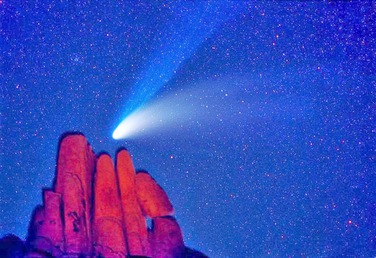Astronomers Alan Hale and Thomas Bopp separately discovered Comet Hale-Bopp on July 23, 1995. Both astronomers were observing the globular cluster M70 when they noticed the mysterious new object, the most recent great comet to pass close to Earth.
When Comet Hale-Bopp was discovered, it was still 7.15 AU from Earth, halfway between the orbits of Jupiter and Saturn. Comets aren't usually discovered until they're much closer, causing scientists to predict that Hale-Bopp was an unusually large comet and one that would become quite bright during its journey into the inner solar system.
Over the next two years, Hale-Bopp more than lived up to expectations. At its brightest in early 1997, it reached magnitude -1. A straight gas tail and a curved dust tail both stretched across 20 degrees of sky. By the time Hale-Bopp finally faded away near the end of 1997, it had been visible to the naked eye for 18 months.
Some 4,000 years from now, this mighty comet will return again.
